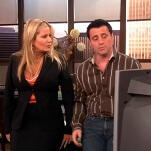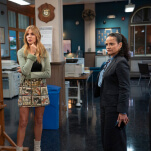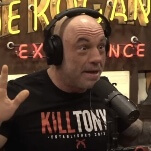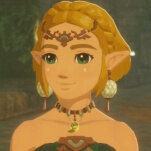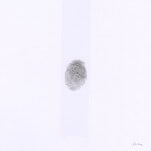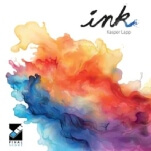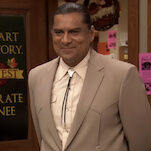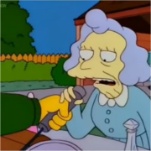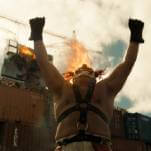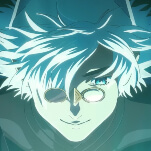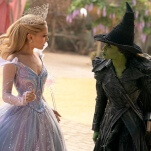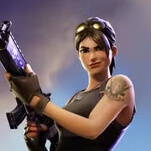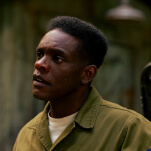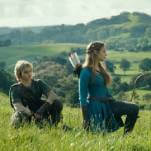More than half of James Sturm's America: God, Gold, And Golems (D&Q) is taken up by "The Golem's Mighty Swing," an acclaimed graphic novella about the barnstorming Stars Of David all-Jewish baseball team. While a lot of comics fans already own "Golem" (or should), the book's remaining two stories deserve more attention. "The Revival" takes place in the early 18th century, and explores the limits of faith, while "Hundreds Of Feet Below Daylight" examines the after-effects of greed and racism in an 1880s mining community. All three stories use Sturm's thick-lined, almost archaic-looking style to create an atmosphere of plainness and historical verisimilitude, which Sturm subverts with scenes of pure fantasy or extreme emotion, before returning to an eerie hush. These three stories represent some of the best American comics of the past decade, which makes James Sturm's America an essential volume for any serious comics library… A
Captain Marvel once sold more comics than Superman and Mickey Mouse, but today, he's known best to deeply immersed comic-book fans and those old enough to remember his starring role in the low-budget 1970s TV series. But the core concept—a little kid gains superpowers via the magic word "shazam"—is too strong not to get a revival. Bone creator Jeff Smith spent years working on Shazam!: Monster Society Of Evil (DC), now available as an oversized hardcover, and the effort is there on the page. Smith's animation-inspired art and storytelling makes an excellent fit for the Big Red Cheese. But more importantly, the subtle emotional pull familiar to Bone readers translates just as well. Between the outsized fights with bad guys, Smith finds real pathos in the story of a child who has the power of mighty gods, but never really had a family… A-
With the comics-to-film adaptation 30 Days Of Night about to hit theaters, it makes sense that DC would want to capitalize on the increased profile of creator Steve Niles by launching his new ongoing series, Simon Dark. But issue #1 of the new title is more generic than promising. A ritual killing at a burned-out gothic church draws the attention of a mysterious hero in a stitched-together Leatherface mask and a stitched-together identity: striped Freddy shirt, The Crow's color scheme and behavior, Edward Scissorhands' pathos and lost, dangerous-child feel. After he decapitates one of the killers and warns off the others, he heads below to brood about his lack of memories about his own identity and origins. Meanwhile, a medical examiner whose path is clearly destined to cross his investigates the situation, and the ritual killers plot more sacrifices. Scott Hampton's gothy art is pretty enough, and the whole package is slick and compellingly executed enough to make the second issue worth a look. At the same time, it's set in Gotham, which makes it dangerously likely that it'll just wind up featuring the usual rogues' gallery and hero squad… B-
Combining a secret society and investigations into the sort of paranormal happenings that settle on London clubs, the new Vertigo series The Vinyl Underground seems like it came straight out of the Vertigo Idea Factory, a late product of the same division that produced Hellblazer and The Invisibles. (It even has a hero named Morrison.) But while the first issue owes a lot to its predecessors, TV writer Si Spencer (Eastenders, Torchwood) writes dialogue and narration with a cheeky energy, and the art by Simon Gane and Cameron Stewart pops with a mod energy that suggests it may find its own voice before long… B
Damon Hurd exemplifies a generation of indie comics writers who strive to bring maturity to the form, yet have trouble avoiding formulaic melodrama. Hurd and artist Tatiana Gill follow up their teen-angst novella A Strange Day with a sort of prequel, Pictures Of You (Alternative Comics), showing Day's soulmate characters Miles and Anna in their formative years, before they met. Like A Strange Day, Pictures Of You has a nice slice-of-life quality, and the way Gill threads the lyrics to Cure songs through her panels creates a real sense of the looming melancholy of post-adolescent alterna-kids. But though everything about the characters and their behavior is believable—right down to their bruised home lives—the cycle of unrequited love and missed connections feels too flat and familiar, and it isn't realized in an especially personal or dynamic way. This is comics for people who think the medium can be just as good as TV or movies, but not for those who think it can be better… C
It's always a letdown to see a talented creator pump out bland product for a buck—especially if that creator is Stray Bullets' David Lapham, the man who almost single-handedly launched the current comic-noir craze. Still, a guy's gotta eat, and Marvel's current five-issue reboot of Terror, Inc. isn't exactly wretched. But it ain't great, either: Taking the original idea of an immortal warrior to its graphic, ghoulish extreme, Lapham traces the life of Mr. Terror, an ostensibly amoral barbarian who's cursed to wander the world forever in a rotting body, constantly foraging for fresh limbs and organs. Today, Terror is a mercenary on the wrong end of a double-cross—and while artist Patrick Zircher knows how to vividly render gashes, spurts, and necrotized tissue, that isn't enough to animate Terror's dull story. At its best, Terror, Inc. is Highlander meets Sin City; at its worst, it's a gory mess… C
Another amazing writer who's been dragging his feet lately is Grant Morrison. In spite of some interesting, though stiff and awkward, work on the slightly overrated All-Star Superman, Morrison's recent run on Batman (DC) is a disappointment. After the decent, workmanlike Batman And Son and an anticlimactic Batman 666, the latest arc, issues 667 to 669, hasn't risen above the batch. But it should have: An old-school, snub-nosed detective story that resurrects The Club Of Heroes—formerly known as The Batmen Of All Nations, a group of would-be semi-Dark Knights created in the '50s—the story is the perfect vehicle for Morrison's underdog-revamp expertise. Apparently, though, the scribe was asleep at the wheel: Confusing brevity for gravity, Morrison doesn't dish out enough plot, quirks, or ideas, and the whole thing winds up empty and inconsequential. And as eye-puckering as J.H. Williams III's richly intricate art is, the story's retro feel would have been served much better by, say, Darwyn Cooke. Hey, a reviewer can dream… B-
Speaking of revamps, writers Jimmy Palmiotti and Justin Gray deserve some credit: It takes a significant effort to convert Grant Morrison's blueprint for Uncle Sam And The Freedom Fighters into a wad of clichés, fumbled pacing, top-heavy dialogue, and rote realpolitik. After the duo's eight-issue, Infinite Crisis spin-off, a new miniseries follows the adventures of the titular icon—and it's almost possible to hear Palmiotti and Gray grunting with the strain of trying to make Uncle Sam sound edgy and relevant. Renato Arlem's dependence on recycled panels—is he really too lazy to draw the same character twice on the same page?—doesn't help, though his grainy shots of alien bugs and the haggard, weathered Sam are a treat. As a nation, though, aren't we past the dark days when it was okay for superheroes to recite volumes of tech-speak and pedantic exposition while kicking the shit out of bad guys?… D+
After leaving Marvel under still-cloudy circumstances, Spider-man co-creator Steve Ditko moved on to other companies to work on his own creations. These included the shoestring Charlton Comics, where he penned and drew the adventures of The Question, an avenger who wore a faceless mask and adhered to the Objectivist principles Ditko held dear. In the '80s, DC acquired the rights to the character and handed him over to writer Dennis O'Neil and artist Denys Cowan. Best known for bringing a social (read: liberal) conscience to comics in the '70s, O'Neil turned Ditko's creation around 180 degrees in a late-'80s run now being collected into trade paperbacks. The Question: Zen And Violence (DC) reprints the first six issues, which steep the hero in doubt and lead him to favor the mysteries of various Eastern philosophies over Objectivist surety. The revamp works better in concept than in execution, as O'Neil recklessly mixes noir darkness, philosophy 101 musings, and way-'80s bad guys, including an evil televangelist. But it remains an intriguing concept, and Cowan's art has held up well… B-
Writer Christian Westerlund and artist Robert Nazeby Herzig try to push comics storytelling a little further in Angel Skin (NBM/ComicsLit), a slim volume that tells the tale of a suicide's adventures in a gothic limbo resembling skid row as re-imagined by Trent Reznor. Herzig's Dave McKean-like illustrations are certainly vivid, as they swing between cartoony and darkly real, but Westerlund's script is one long, decadent, ultimately dull wallow in morbidity and scuzz. The duo make an admirable attempt at visualizing and dramatizing the tortures of a soul in crisis, and giving it a "hard fantasy" spin, but anyone under 15 or over 22 need not apply… C-
First self-published in 1996—with the benefit of a Xeric Grant—David Yurkovich's Death By Chocolate suffers some from the writer-artist's awkwardly "literary" prose and a tone distilled from Grant Morrison comics, but his inky, abstracted art remains striking to look at even now, and the book has a uniquely haunted quality that Yurkovich has expanded on in subsequent installments. Death By Chocolate: Redux (Top Shelf) brings the hard-to-find chapters of Yurkovich's "Agent Swete" saga together under one cover, from his origin as a chocolate-dipped alien-human hybrid—with the power to turn people and objects into chocolate—to his involvement with a shadowy government agency that pursues food-related conspiracies. That may sound hopelessly quirky, but it's really more absurdist—sometimes incomprehensibly so. Yet Yurkovich's twisty imagination carries readers along, aided by a strong undercurrent of yearning, as these stories become increasingly about men bound by responsibilities they never asked for… B
A Xeric Grant also helped Stylish Vittles' Tyler Page bring Nothing Better Volume 1: No Place Like Home (Dementian) to print earlier than he'd planned. Fans of Alex Robinson (Box Office Poison, Tricked) looking to fill the downtime between his meticulous projects finally have their methadone; Page's leisurely, detailed examination of a handful of naïve freshmen entering a Lutheran college strongly recalls Robinson's work, right down to the style of his black-and-white art. (In particular, the characters' embarrassed grin-and-blush routine looks exactly like Robinson's.) Largely centering on two roommates—one a virginal, strait-laced Christian who hasn't examined her own beliefs closely in a long time, the other a more hedonistic, spontaneous artist struggling to put herself through college—the story sprawls out into the lives and loves of the many people around them, and returns repeatedly to their religious beliefs, or lack thereof. Page's art and his panel order can be sloppy, and he tends to reduce his minor characters to caricatures—while all the hot characters talk religion, science, relationships, and philosophy, the one fat girl does nothing but eat, weep, and slouch around in bunny slippers, while the one really skinny girl does nothing but natter in great detail about her Dungeons & Dragons campaign. But the characters Page cares about are beautifully nuanced, with the blend of insecurity, excitement, conflict, humor, and depth that makes Robinson's work so wonderful. (There's a little of Craig Thompson's Blankets in there too, actually.) In particular, his insight into the minds of early college students is spot-on; it's hard to decide whether to sympathize with them or slap them as they grapple with the big questions as though no one has ever considered such things before. Like the current incarnation of Phil and Kaja Foglio's Girl Genius, Nothing Better continues to play out online in full-page installments that are clearly more print preview than webcomic. Which means after finishing this thoroughly enjoyable seven-issue first volume, new fans can check out the next four issues through stylishvittles.com… A-
Devilish Greetings: Vintage Devil Postcards (Fantagraphics) is, as the title implies, a collection of postcards—mostly European in origin—depicting Satan in everyday situations: playing cards, drinking beer, tormenting sexy ladies, posing with products for a fee, and so on. (Nothing's beyond the Dark Lord.) Postcard compiler and book designer Monte Beauchamp also founded the avant-garde comics anthology BLAB!, and like his work there, Devilish Greetings has a kind of impenetrable design-for-design's sake quality. But then, comics are essentially a form of commercial art, and it's useful to have theoreticians like Beauchamp around to remind people of that, even if the books he creates are more for storing and skimming than for poring over… B-
Of course, there are ways to archive comics history while still being approachable, and even entertaining. Buenaventura Press' Comic Art Annual blazes trails in that regard. Comic Art Annual #9 is the series' best installment yet, bringing together a lengthy overview of seminal Raw artist Jerry Moriarty (complete with notes by Moriarty himself), a run of Sunday Dick Tracy strips from the '50s, analyses of the work of mid-20th-century cartoonists Abner Dean and Gluyas Williams, a biography of punk comics icon Kaz, and more. Between the historical context and slick reproductions of art both high and low, Comic Art Annual #9 covers a lot of ground, some fairly fallow, but most incredibly rich… A-
Following on the heels of last year's acclaimed autobiography Kampung Boy, writer-artist Lat returns with the sequel, Town Boy (First Second), about his teen years growing up in a Malaysian village, where he discovered the hypnotic pull of music, art, and girls. His cartoony, expressive black-and-white style continues to recall Sergio Aragones to some degree, especially in big crowd scenes, but the stories about Malaysian life are all his own. His books aren't meant as primers on his culture and country—some of the references and the language quirks are fairly opaque—but they're excellent windows both into his way of life and into the mind of an awkward teen and a budding artist… B
Ask any frustrated Lost fan: Mystery-driven serials can sometimes groan under the load of their own mythos. So how does writer Antony Johnston pull off Wasteland (Oni)? Twelve issues into the monthly series, Johnston is just getting better at developing characters, building a world, and dovetailing quiet, tiny emotions with thunderous, reality-quaking fantasy. But best of all, he knows how to feed readers puzzles and solutions in perfect doses. The tale of a barren, post-apocalyptic Earth—and the survivors' struggles for political, religious, economic, and even sexual freedom—Wasteland radiates in about a dozen conceptual and philosophical dimensions at once. But it's pure mystery at its core: A century after the collapse of what appears to be civilization as we know it, bands of hardscrabble settlers scour a scorched landscape looking for sustenance, security, and signs of an apocryphal homeland called A-Ree-Yass-I. Issue 10 was a breakthrough—the first glimpse of memories of modern-day America—but as with the best enigmas, more questions are asked than answered, and the suspense in the last two issues unfolds exponentially. Johnston's dance between characterization and concept is dizzying but not disorienting, and Christopher Mitten's organic layouts and crisp, textured visuals magnify the story's depth and soul. Wasteland gets favorably compared to everything from Y: The Last Man to Finder (whose Carla Speed McNeil sat in on Wasteland 7), but in essence and execution, it rivals Hayao Miyazaki's masterful epic Nausicaä—and with a second trade collection due in December, Wasteland is just warming up… A-
Another strenuous exercise in world-building—albeit one that looks backward rather than forward—is Gutsville (Image). Issue 2 of the six-part series expands one of the richest alternate-history premises in recent memory: What if a ship bound for Australia in 1850 was swallowed by a whale-like leviathan, but the passengers survived and built a city inside the beast? In 2006, a century and a half after "The Swaller," Gutsville is a sprawling berg about to burst with vestigial Victorian repression, simmering rebellion, and (of course) a religious sect with a strong Jonah complex. Grounding it all is Albert Oliphant, an endearingly hapless, misfit rat-catcher who dreams of escaping Gutsville, even if it means facing hallucinogens, horrors, and the ultimate secret of the being he lives within. Heavily indebted to China Miéville as well as Jules Verne, creators Simon Spurrier and Frazier Irving craft a lurid, absorbing story—although the book, like the city of Gutsville itself, feels a bit confined in spots, with pacing and suspense kept to a dull roar. But with most of the series still on the horizon—and a sequel already hinted at—Gutsville is well worth climbing aboard… B+
Just in case readers of Space Pinchy (Dark Horse) somehow missed the fact that Japanese writer-artist Tony Takezaki really wants them focusing on his heroine's crotch, ass, or boobs in every panel, he has a character hanging around to direct their lecherous responses—and probably put them entirely off lechery in the process. Takezaki's super-glossy, bright, vivid computer art and his storyline about the pulchritudinous descendent of a lost civilization might have been interesting, but her sidekick's nonstop graphic shrieking about her physical assets rapidly goes from distracting to disgusting to just plain boring. Pinchy, supposedly the last of a "legendary ancient space race called the Pinchians," roams the galaxy nabbing Pinchian artifacts, fighting off their weird guardians, and frequently exercising her ability to use her "anti-pinch cells" to assume an appropriate new form every time she's in "a life-threatening pinch." Meanwhile, her partner Audrey (a shrieking blue naked cherub-thing clearly modeled after Little Shop Of Horrors' Audrey II, complete with smooth eyeless head and disconcertingly full lips) packs every panel with commentary like "Ooh, Pinchy! I can feel your cries ringing out in my cock! More, more! That voice is making me hard!" and "When I see you spread you legs when you're dodging, I can't stop looking at your crotch! Seeing your pelvis and your beaver like that, I can't take it any more!" In spite of all the graphic language, Space Pinchy features very little nudity and no sex; it's all loud adolescent tease, crammed with exclamation points and crude innuendo… D+
Farting submarine commanders, cola-drinking knights, human-on-jellyfish sex: The shocking surrealism of Powr Mastrs is a lot to digest. But the graphic novel's absurdity is as benign as it is sublime: Writer/artist C.F.—in what promises to be the first in a series—fuses wispy yet gorgeously drafted images with a phantasmagorical tale of New China and its dream-figment inhabitants. The mythic code floating under Powr Mastrs is strongest because it's still locked—although it's wondrous fun to poke around in its teeming weirdness. Another intriguing, beautifully packaged new book on Picturebox Inc., Maggots is the exhumed brainchild of Brian Chippendale, drummer of the noise-core juggernaut Lightning Bolt. He brings the same impossibly wound energy and insanity to Maggots: In 250 tiny pages scrawled on the guts of a Japanese catalog back in 1997, Chippendale's mostly wordless tale is murky, disturbing, and singular in its command of near-mystic iconography. It isn't for everyone—but then again, Lightning Bolt is a bit of an acquired taste, as well… Powr Mastrs: B+; Maggots: B
Puncturing goth pretension with plastic fangs, Byron: Mad, Bad, And Dangerous (Slave Labor) is a loving deconstruction of the vampire-comics glut. Sprinkled with everything from H.P. Lovecraft and EC to Peter Cushing and subcultural politics, writer-artist Karl Christian Krumpholz weaves a diabolical yet lightweight tale of Byron, an ersatz goth who winds up tangled in the vicious plots of real vampires. It's clear that Krumpholz is injecting some firsthand observations into his fiction, and he likewise lends quirky soul to his artwork, which imagines a cuddly Richard Sala jamming with Tim Burton. B

